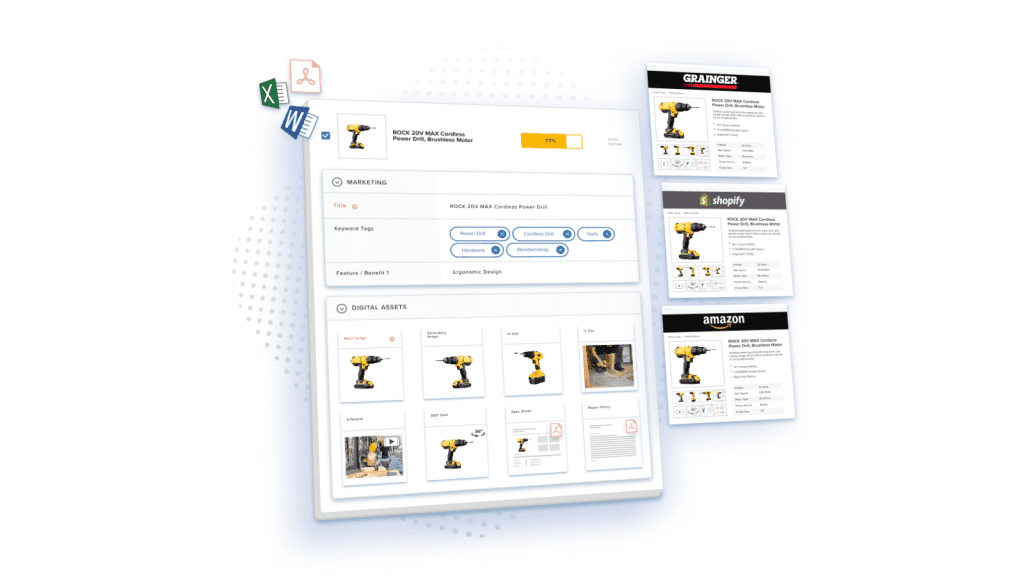Unlock Growth for Industrial Brands Through Product Diversity

- Product diversification allows industrial brands to fuel growth by expanding into complementary products beyond current catalogs.
- This strategy mitigates risk, increases revenue streams, and boosts market share if executed well.
- Industrial brands should evaluate market gaps, leverage core competencies, and follow best practices to introduce new products successfully.
In this Article
Brands face constant pressure to maintain relevance amid market fluctuations and emerging competition. This reality makes relying solely on legacy product lines risky business.
Studies indicate that product diversification can help brands to navigate the risky business landscape. For example, a McKinsey study established that most diversified companies created the highest excess returns. In contrast, none of the pure plays surveyed managed this feat.
However, venturing haphazardly into unfamiliar spaces also dilutes focus and quality. So, how can B2B organizations expand their portfolio strategically?
This article dives into product diversity and explores the types of product diversification. It also guides you to create an effective product diversification strategy and explains why PIM and DAM are essential tools for a successful NPI.
What is Product Diversification, and Why Does It Matter?
Product diversification is a business strategy of expanding into new product lines and categories beyond a company’s current offerings. The main objective is to achieve higher sales volume and potentially increase profitability from new products.
Diversification typically occurs at two levels: business or corporate.
Business-level product diversification
Product diversification at this level involves a brand expanding into new product segments within its existing industry.
For example, a power tools manufacturer would diversify its product lineup with new but related categories. If the company initially produced only power drills, it may add screw guns, sanders, planers, and other complementary products to become a more exhaustive power tool provider. This leverages existing manufacturing and stays in the realm of power tools.
Corporate-level product diversification
Diversification at this level involves more significant expansion beyond core products into new industries.
Instead of introducing new products only, the power tools manufacturer would venture into entirely new industries such as pneumatics, lawn equipment, or welding supplies. This takes the company into new territories and product lines like compressors, generators, mowers, etc. The company may need to create new customer segments in fabrication, landscaping, and more to serve these new niches.
Expanding into new industries is more challenging and resource-intensive. Businesses would need to utilize some high-level engineering and distribution assets. Also, a successful transition requires developing new competencies in distinct product domains.
The primary distinction is that business diversification enhances an existing catalog, while corporate diversification aims at new divisions. Also, business-level diversification is generally viewed as less risky as new offerings stay closer to current competencies. However, corporate diversification enables access to untapped markets and broader growth potential despite more uncertainty.

Product Diversification As A Core Growth Strategy
Igor Ansoff presented a matrix outlining four core growth strategies that businesses can pursue based on whether they are creating new products or entering new markets. The matrix is a visual framework that maps out the four core growth strategies businesses can leverage.
Picture a four-quadrant grid:
- Existing Products, Existing Markets: Your bread and butter – the drills, saws, and sanders that keep your brand going.
- New Products, Existing Markets: Venturing into uncharted territory within your familiar customer base. Imagine offering innovative laser levels alongside your traditional tape measures.
- Existing Products, New Markets: Targeting fresh audience segments with your current offerings. Think expanding your reach from DIY enthusiasts to professional construction teams.
- New Products, New Markets: The ultimate leap of faith, introducing both new tools and targeting new customers. Picture an exclusive line of power tools designed for eco-conscious builders.
Product diversification occupies the “New Products” portion of the matrix. It represents one of the four core growth strategies at the center of Ansoff’s framework. The four growth strategies are:
- Market Penetration: Selling more of current products to existing customers
- Market Development: Taking current products into new customer segments
- Product Development: Creating new products for existing customer base
- Diversification: Expanding into new products as well as new markets
Diversification represents the most ambitious yet riskiest approach, as it requires mastering new product creation and market navigation capabilities. However, if executed well, it provides access to the most tremendous growth potential.

Key Reasons Brands Diversify
If product diversification is the riskiest of the four growth strategies, and yet companies are not afraid of pursuing it, it means the payoff is sufficiently convincing. Some reasons industrial brands embrace diversification to grow their businesses include:
Increasing overall revenues
Expanding into new product categories inherently pushes the boundaries to the scope of revenues you can generate in a given period. A broader catalog appeals to more comprehensive needs and opens transaction opportunities beyond what current offerings cover. In other words, more products equate to more pathways to close sales, boosting the total revenue upside.
For example, an industrial air compressor company adding vacuum systems and pneumatic tools doubles or even triples product breadth. The new products provide additional sales touchpoints across distribution channels and customer groups. Instead of relying solely on compressor sales, overall revenues have more contributors across a product spectrum.
Three justifications rationalize this motivation for product diversity:
- Diversification provides a pathway to capitalize on additional revenue sources.
- It helps offset declines in one product category with growth in others.
- Brands can leverage established customer relationships to cross-sell new products.
Spreading risk across product areas
Lean too heavily into one product segment and your brand can experience major struggles if demand shifts for any reason. Market changes, new technology, or competition can leave previously strong products suddenly vulnerable.
Diversification provides the best risk hedge – it ensures no single product line carries too much responsibility for revenues and growth. Some product segments may experience growth while others decline, given market fluctuations, providing financial stability.
The key points to note are:
- Diversification minimizes vulnerability to market-specific challenges.
- It provides a buffer against economic downturns impacting specific industries.
- Brands can navigate unforeseen disruptions more effectively by having a diversified product portfolio.
Gaining market share via customer reach
While deep market penetration has merits, diversification can expand market share by simply appealing to more customer groups. A company viewed as a one-trick pony may be less attractive to some buyers than a more versatile brand with diverse offerings under one roof.
Even existing customers may purchase from competitors if lacking solutions for adjacent needs. Fulfilling broader needs of current clients while accessing net new groups raises the addressable market scope and market share ceiling.
The bottom line is that diversifying products allows industrial brands to penetrate new customer segments, broadening their market reach and strengthening their competitive position.
You can justify the motivation behind this reason as follows:
- Diversification enables brands to meet diverse customer needs and preferences.
- It facilitates entry into untapped markets, enhancing market share.
- Brands can establish themselves as versatile and adaptable, appealing to a broader audience.
Leveraging existing capabilities across new products
Product diversification works best when current organizational strengths and assets apply clearly across new verticals. This minimizes reinventing competencies while maximizing transferability.
For example, research and development (R&D) skills, patent portfolios, manufacturing expertise, distribution channels, and existing vendor/supplier relationships can often stretch across diversification moves.
Consider a company like General Electric (GE). Initially a pure-play electric company, GE diversified into aviation, healthcare, and renewable energy by leveraging its electrical engineering and manufacturing expertise.
Some justifications the leadership at GE might have presented to stakeholders before pursuing the diversification strategy include:
- Diversification leverages core competencies, reducing the learning curve.
- It allows brands to explore adjacent markets without starting from scratch.
- Industrial brands can achieve economies of scale by utilizing existing resources and expertise.

Types of Product Diversification
Concentric diversification
Concentric diversification involves introducing new products that are closely related to existing offerings in terms of technology, function, production processes, and markets. This close adjacency allows for the effective utilization of existing competencies.
Think of it like this: your brand excels at crafting high-torque drills. Concentric diversification wouldn’t send you off to make blenders or lawnmowers (that’s horizontal diversification; we’ll get to that later!). Instead, you’d deepen your existing product category by venturing into related offerings. Here’s how that could play out:
- Introducing specialized drill bits: Your brand could offer a range of drill bits designed for specific materials, like masonry, tile, or even delicate glass. This expands your appeal to niche markets and increases the value proposition of your core drills.
- Developing compatible attachments: Imagine your company’s drills that transform into sanders, polishers, or even mini saws with the help of interchangeable attachments. This flexibility would keep customers coming back for more, boosting your revenue and brand loyalty.
- Crafting innovative accessories: Think ergonomically designed handles, dust extraction systems, or laser guidance attachments that enhance your existing drills’ functionality and user experience. These value-added offerings give your business a competitive edge and cater to customer needs in ever-evolving ways.
Concentric growth enables businesses to carefully stretch in logical next steps where learning curves are surmountable. It follows the idea of “close leaps rather than giant leaps” – inchworming outward bit-by-bit based on building blocks already mastered.
This controlled evolution expands a catalog while minimizing risk exposure from overstretching capabilities that have not yet been developed. For industrial brands, concentric moves unlock growth while upholding a quality reputation.
Horizontal diversification
Horizontal diversification means adding new products that may serve the same customer groups but are not closely integrated with current offerings. There is some familiarity, but there are also novelties requiring new competencies.
This diversification approach might seem like a leap of faith, but within the proper strategic context, it can be a powerful growth engine for your brand. Here’s how it works:
- Expanding into complementary products: Your brand could leverage its knowledge of dust and debris to develop innovative air filtration systems designed explicitly for workshops. This caters to a related need within your existing customer base, creating a value-added ecosystem around your core offerings.
- Offering safety and maintenance solutions: Think of branded safety goggles, ear protection, and even tool maintenance kits. This taps into your customers’ safety concerns and builds brand loyalty by establishing your brand as a one-stop shop for responsible power tool use.
- Venturing into educational services: Imagine online tutorials on woodworking techniques, tool safety awareness programs, or even DIY project workshops hosted by experts from your company. This capitalizes on your brand’s expertise and expands your reach to a broader audience, potentially including aspiring DIY enthusiasts or professional training centers.
This tactic can be more successful if you choose products or services that resonate with your existing customer base, complement your brand identity, and leverage your existing resources.
Look at it this way: Horizontal diversification broadens the catalog scope into related but distinct product universes compared to concentric moves. The customer tie remains, but product adjacency expands.
Conglomerate diversification
Conglomerate diversification constitutes the most aggressive form, expanding into entirely new products and markets. Think of it as the purest form of corporate diversification. Here, prior organizational competencies may have minimal overlap, requiring a build-up from near scratch.
Relating to your power tools brand, a conglomerate move might be to expand into children’s toys, electronics, or even pharmaceuticals. These represent radical departures from anything related to tools aimed at construction/industrial buyers.
This approach to product diversity holds significant potential for opening doors to unimaginable growth opportunities. Some potential advantages include:
- Access new markets and revenue streams: Tapping into completely new industries can open doors to entirely new customer segments and revenue sources, diversifying your portfolio and mitigating risk.
- Leverage brand recognition and reputation: Your established brand equity can work wonders in attracting attention and establishing trust in unrelated ventures.
However, this strategy presents several challenges, including:
- High risk and resource investment: Diversifying far beyond your expertise requires significant resources and increases the risk of failure. For example, the expertise needed to run a coffee shop vastly differs from crafting power tools.
- Loss of brand focus and dilution: Stretching your brand too thin into unrelated areas can dilute its identity and weaken customer recognition.
- Management complexity and logistical challenges: Integrating and managing diverse businesses requires substantial expertise and organizational agility.
Conglomerate diversification can be a bold, high-reward strategy, but it demands careful evaluation and meticulous planning.
Before venturing into uncharted territory, analyze your brand’s strengths, market opportunities, and available resources. Ask yourself:
- Does this new business align with our brand identity and values?
- Do we have the expertise and resources to manage this effectively?
- Will it enhance our existing offerings or risk diluting our brand focus?
If you can answer these questions confidently, then by all means, venture beyond the workshop walls and explore the possibilities.

How to Implement an Effective Product Diversification Strategy
Product diversity is robust, but you won’t earn even the slightest benefit with a poorly executed strategy. Successful product diversification requires a structured plan and flawless execution.
Read Also: Benefits of PIM
Here is how to build a toolkit for successful implementation:
Stage 1: Laying the foundation with market research
All things that start with a clear understanding of the current landscape have a better chance of success. So, before adding a new product to your digital catalog, uncover your customers’ needs and desires.
Are they craving cordless, compact drills for smaller projects? Do they yearn for dust filtration systems that banish workshop sneezes? What about online tutorials to hone their crafting skills? Identify unmet needs within your existing customer base and explore opportunities in related markets.
Some tactics to deploy here include:
- Conduct comprehensive market analysis to understand customer preferences, industry trends, and potential gaps in product offerings.
- Leverage customer surveys, interviews, and competitor analysis to gain insights into unmet needs and areas for innovation.
- Explore emerging technologies that could open new avenues for product development in the power tools industry.
Stage 2: Assessing your capacity for growth
Market research paints the picture, but your operational capabilities are the brushstrokes that bring it to life. So, analyze capabilities like your current manufacturing capacities, supply chain strengths, and distribution channels.
Ask yourself questions like: Can your existing infrastructure handle new product lines? Do you have the expertise to develop and market them effectively?
The goal should be to upgrade selectively to venture into expansion only where sustainable quality, efficiency, and value creation exist.
Stage 3: Developing detailed business plans for each new product introduction
A comprehensive business plan is a roadmap for successful new product introductions (NPIs). It outlines critical objectives, target markets, financial projections, and marketing strategies.
Some tactics to deploy include:
- Clearly define the goals and objectives of each new product introduction.
- Conduct a thorough financial analysis, including cost estimates, pricing strategies, and revenue projections.
- Develop targeted marketing plans that consider the unique selling propositions of each new product.
Stage 4: Allocating resources
Carefully direct budgets, talent, and infrastructure towards diversification initiatives without starving core products. Seek optimization between fueling existing business health and pioneering additional vectors. Assign dedicated teams towards new product lines to divide focus appropriately.
Stage 5: Listening to your customers
Diversification isn’t a set-and-forget game. Instead, stay keenly aware of customer sentiment, product performance data, and market responses to introductions.
Do this:
- Implement feedback mechanisms such as surveys, customer service interactions, and online reviews to gather insights.
- Utilize analytics tools to track customer behavior, product usage patterns, and market trends.
- Actively engage with customers through social media platforms and other channels to foster a continuous feedback loop.

DAM and PIM Solutions for Easy and Seamless NPI Across Channels
Data management is one of the main challenges of new product introductions (NPIs). Every new product generates hundreds of attributes, technical specifications, and digital assets. You’ll quickly run into an unmanageable situation when new products increase.
Luckily, solutions exist. Product information management software and digital asset management software provide capabilities for streamlining NPIs – especially regarding data and asset management challenges.
Here is how PIM and DAM Systems streamline multi-channel NPIs:
1. Centralizing your product data
Think of PIM DAM Solutions as the single source of truth of product information and digital assets for all your products. With a centralized and standardized platform for your product data, you can eliminate inconsistencies and errors that can confuse customers and hinder cross-channel marketing.
These capabilities address a significant challenge: disparate data sources and decentralized information can hinder effective product management.
Streamlined data management enhances efficiency and reduces the likelihood of errors during product diversification initiatives.
2. Easily customize product information for different customers/markets
A typical industrial brand caters to individual and business buyers. This nature of business raises a critical challenge when introducing new products: How do you tailor product information for different customer segments and markets?
PIM and DAM integration allow brands to avoid channel-specific data silos – you can syndicate information to multiple channels in one go. Even better, the tools have robust customization features to quickly adapt product information based on customer needs, market requirements, or regional preferences.
3. Workflows for fast and easy cross-team collaboration
New products require the undivided attention of new teams. However, the new team(s) feed on the brand’s core competencies and resources, implying that there will be close collaboration with existing teams.
What if the teams cannot collaborate efficiently? Product information management tool and DAM facilitate seamless communication and coordination across teams. As such, any collaboration bottlenecks and delays are avoided. The digital asset management program and PIM Tool can define clear roles and responsibilities within workflows, ensuring efficient cross-team collaboration.
4. Maintain data quality and governance as the portfolio diversifies
As product portfolios expand, maintaining data quality and adhering to governance standards becomes increasingly challenging. DAM tool and PIM software allow users to implement robust data quality and governance protocols, enabling the brand to uphold accuracy and compliance with every new product.
However, regularly audit and update data quality parameters as the product portfolio evolves.
Key Takeaways
The B2B landscape is challenging, especially with constant customer preferences and needs shifts. So, pursuing strategic product diversity is one of the surest approaches to fuel growth and defend market share.
However, this strategy must align with customer needs and business strengths. So, conduct a diligent assessment of market gaps and internal capabilities to inform expansion. Choose options that leverage existing assets to improve the odds of seamless adoption.
With a clear understanding of new segment viability, industrial brands can pursue selected diversification plays to unlock sustainable revenues. See how Catsy’s Shopify PIM can help with your eCommerce success.
The three main types are concentric diversification (closely related products), horizontal diversification (somewhat related products), and conglomerate diversification (entirely unrelated products). Concentric diversification tends to build most directly on existing competencies.
Avoid diversification when current product lines show extensive growth potential from core customer groups. Stretching capabilities too thin too early over ambition can undermine focus.
Diversification can be risky, but so is staying stagnant in a competitive market. By spreading your eggs across multiple baskets, you mitigate risk and ensure your business isn’t reliant on a single product or market. Think of it as building a stronger, more weatherproof brand. However, careful planning and a thorough understanding of your customers and market are crucial to minimize risk and maximize success.
Absolutely! Diversification doesn’t always require launching significant new product lines. Start small by exploring concentric diversification, offering accessories, upgrades, or specialized versions of your existing products. You can also leverage partnerships with other brands or provide complementary services like online tutorials or workshops.
There’s no one-size-fits-all solution. Consider your brand’s strengths, resources, customer base, and market opportunities. Do you want to expand within your existing market (concentric), venture into new segments (horizontal), or even explore entirely different industries (conglomerate)? Analyze each option carefully and choose the one that aligns best with your goals and capabilities.




